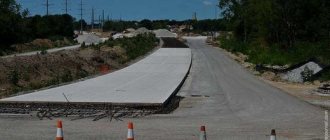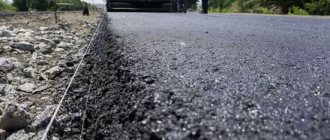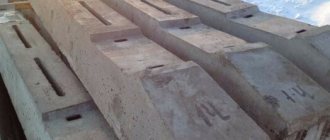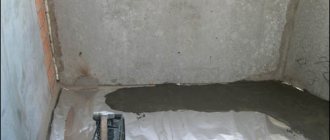Viscosity grade and laying temperature
The component responsible for viscosity is bitumen. The more of it there is in the material, the more plastic the asphalt is. But bitumen remains plastic only at high temperatures. Cooling causes hardening. Therefore, such mixtures are called hot. The advantages of such asphalt include an affordable price and good performance characteristics. That is, it is durable and cheap. Therefore, it is an undisputed favorite. Hot asphalt has one significant drawback - it cannot be worked with at temperatures below 10 degrees, and rain and fog are also contraindications.
Cold asphalt can be laid in any weather. It contains the same components as in hot mixes, but additionally contains a large portion of polymers and plasticizers. They do not allow the bitumen to harden. The mixture remains plastic at low temperatures. However, such material does not demonstrate high strength and is also quite expensive. This determined its scope of application - emergency road repairs.
Description of the material, its types and brands
Asphalt is a stable material for creating smooth roads. Cars move along them silently, produce less harmful emissions into the atmosphere, and consume much less fuel. Asphalt is made from bitumen, stones, sand, gravel and other fillers. There are many types of asphalt.
Cold
Cold asphalt is used as an all-weather mixture, mainly for road repairs. Working with it is simplified as much as possible. All dirt is removed from the old coating, the edges of the pit are framed, and the cold mixture is poured into the pit. After which it is compacted and sprinkled with cement dust or sand in order to avoid sticking when the first cars pass. All work is done manually.
Advantages of cold asphalt:
- Road repairs can be carried out at low temperatures.
- Has a long shelf life.
- No special mechanisms are needed for repairs.
- It has high adhesion, waterproofing properties, and increased stability.
Cold asphalt is stored and transported in special bags or cardboard container barrels. It is completely ready to use, without preheating or preparation.
In the video - cold asphalt:
Hot
Hot asphalt is a traditional and still very common paving technology that requires compaction equipment. Hot asphalt mixture is prepared from stones, the content of which reaches 95%, sand or gravel.
They are bonded together with asphalt cement and crude oil products. The components are poured into the unit, mixed and heated, and then loaded into dump trucks. The asphalt is poured onto the road and compacted using a heavy roller.
Cast
This type of asphalt concrete is popular in Europe. In our country it is less common due to the high cost of the mixture and installation equipment. With the help of cast asphalt, you can easily and quickly build a route, eliminate damage up to 50 mm deep around the construction of routes, and arrange sidewalk and bicycle paths.
Cast asphalt has the same composition as regular asphalt, and differs from it only in a different number of components and installation method.
Cast asphalt is heated to 250? C, at such a high temperature it becomes very fluid and is evenly distributed over the surface. No compaction roller required.
Advantages of cast asphalt:
- Sold ready to use, packaged in a special container.
- Can be used all year round.
- Almost any surface can be easily and quickly repaired.
- Has great resistance to deformation.
- Has great water resistance.
- Not sensitive to salt and chemicals.
- Eco-friendly and harmless.
- Durable.
Laying poured asphalt
Natural
Natural asphalt is obtained from petroleum. Rising to the surface, petroleum hydrocarbon compounds evaporate. As a result, resinous-asphaltene substances accumulate, which oxidize and compact, and turn into harder, easily melting asphalt masses. Natural asphalts contain from 25 to 50% oils, some of them are enriched with sulfur - up to 10 percent or more.
Sandy
Sandy asphalt is made from a mixture that contains a rationally selected composition of fractional grain screenings from crushed crushed stone or sand, having a size of no more than 5 mm. Sidewalks and pedestrian paths are made from this asphalt.
The basis of any asphalt production is the preparation of the starting components, mixing at high temperatures and storage in special heated bunkers.
Sulphated
Sulfonated asphalt is made through the process of sulfonation of natural petroleum asphalt. It is used in the drilling industry, where any water-based drilling fluids are processed. Sulfonated asphalt helps block wellbore cracks, prevent rock slides and rockfalls, and hydrate shale.
Milled
Milled asphalt has become popular in Russia in recent years. Cold milling is more in demand than hot milling. With its help, the old asphalt surface is removed and made more textured in order to lay a new layer in this place. Modern cutters allow you to immediately mix old material with new.
Color
The days of dull gray asphalt are coming to an end. Thanks to modern road construction technologies, many manufacturers began to offer colored asphalt.
Colored asphalt allows you to highlight public transport stops, bicycle paths, parking lots, pedestrian areas, and the territory of educational institutions.
Colored asphalt concrete mixture is made from clarified bitumen to which a coloring pigment is added. Red asphalt is a type of colored asphalt. It is widely used on UAE roads, in places where strict speed limits are required. This driver warning system works well.
Dry
Dry asphalt is sold as a dry powder mixture packaged in plastic buckets or bags. Dry asphalt is prepared from it. Usually there are 30 kg of mixture in a bucket, and 50 kg in a bag. Dry asphalt is intended for pothole repair of asphalt roads.
Liquid
Liquid asphalt is used for hot and cold laying of roads and their repair. It is also often used to fill floors in industrial premises and to equip roofs.
Liquid asphalt
Coarse grain
Coarse-grained asphalt contains fractional grain crushed stone over 20 mm in size. It is used for lower and leveling layers of road surfaces. This coating has a fairly rigid structure.
Fine grain
The fine-grained asphalt concrete mixture contains grain crushed stone up to 20 mm in size. Using this mixture, the upper layers of the road surface are constructed.
Soft
Soft asphalt is used to cover floors in industrial premises. Please note that this type of asphalt is partially soluble in alcohol.
Rubber
Rubber additives in asphalt prevent water from entering the asphalt area, so the asphalt does not deteriorate and remains hard. And although coating with rubber crumbs is more expensive than usual, it lasts a long time and does not require frequent repairs. This allows you to reduce costs in the long term.
Bulk
Using polymer-modified cold asphalt, potholes are repaired in all weather conditions. This product meets all international standards. The main thing when working with it is to carry out proper and thorough preparation.
Secondary
Recycled asphalt is made from asphalt chips, which are obtained by recycling old asphalt. The asphalt removed from the road passes through the milling machine and becomes free-flowing. The average cost of this asphalt is much lower.
This road material is very popular among private homeowners. It is used to make roads on any type of soil. The size of the loosened layer should be at least 12 cm.
Stamped
Stamped asphalt pavement looks very attractive, it is durable and prevents slipping.
Stages of its production technology:
- Asphalt is heated to a soft plastic state using infrared equipment.
- Using special flexible stamps, the asphalt surface is given the desired texture.
- The finished stamp is cleaned and primed.
- The surface is painted with a wear-resistant polymer composition.
Technology for making decorative stamped asphalt:
Plastic
Plastic asphalt is made by adding 20 percent recycled plastic to regular asphalt. In appearance, the coating is similar to the traditional one, but it has many advantages, primarily environmental. It is also beneficial from an economic point of view; the production of plastic asphalt requires significantly less energy costs.
Asphalt grade 2 type b
Asphalt type B grade 2 is made from a fine-grained asphalt concrete mixture, in which the crushed stone content can reach up to 40 percent. This “average” asphalt has a wide range of applications. It is most often gray in color.
The article will tell you about the features of using asphalt pavement and the most important aspects of its repair.
Asphalt porosity
Porous asphalt concrete is obtained when coarse-grained mineral filler is used (fraction of 20 mm and above). This material forms a surface that is elastic, but at the same time does not have a very smooth surface. Therefore, porous asphalt is ideal for the base layer of the road. High-density asphalt is laid as the top layer. It makes the surface perfectly flat and smooth.
There are 4 types of asphalt concrete:
- high density;
- dense;
- porous;
- highly porous.
Technical characteristics and properties
The technical characteristics and properties of asphalt depend on the amount and type of filler and other impurities. All artificial asphalt mixtures are divided into plastic, crushed stone, gravel, sand and others, as well as into types of preparation - cold, hot and warm. All of them can be dense, porous or highly porous and have different qualities and indicators.
GOST
Each type of asphalt has its own GOST, which specifies all its technical standards. Asphalt laying is also carried out in accordance with the requirements of GOST 9128 2009.
Specific and volumetric gravity
The specific and volumetric gravity of asphalt are approximately equal. They are measured in kg/m3 in the MKGSS system.
How much does a cube of asphalt weigh?
When paving roads, it is important to know how much a cube of asphalt weighs, so as not to overuse the material. The mass of a cubic meter varies depending on the type of composition used. To determine the exact weight, you should resort to special tables or contact the manufacturer, whose representatives are required to provide all the necessary information. Approximately one cubic meter weighs 1.2 tons.
Density
The density of natural asphalt is 1.1 g/cm?. kg. The density of artificial asphalt - asphalt concrete depends on its composition and compaction; for fine-grained it will be the highest, after cast.
The compaction coefficient of the asphalt pavement should be at least 0.93% 10 days after the work.
Thickness
The load on the road surface determines the thickness of the asphalt and the type of mixture. Therefore, before laying, they look at the specifics of the road and take into account the expected traffic intensity on it. On average, a new asphalt surface has a thickness of 9 cm, while the thickness of the lower leveling surface is 5 cm, and 4 cm of the upper one.
Road climate zones
Geography, which determines climate conditions, is also important. These conditions determine how long the asphalt pavement will last, and how it will withstand temperature changes and frost heaving of the soil.
There are 5 climate zones:
- Tundra, which is characterized by permafrost soils.
- Forest zone where soils are characterized by excessive moisture.
III. Forest-steppe zone, where soils are moist in certain periods.
- Steppe zone, which is characterized by dry soils.
- Desert-steppe zone with saline soils.
The higher the frost heave indicators, the more plastic the asphalt should be. This will help avoid the formation of cracks. Where the soils are very wet, asphalt is laid that can withstand water saturation. In arid regions, it is recommended to use asphalt with special additives that extend the service life of the asphalt.
Asphalt concrete fillers
Like most man-made building materials, asphalt concrete has a complex structure. It mainly consists of mineral material in the form of crushed stone or sand, as well as bitumen - an organic binder. Depending on the composition and dimensions of these parameters, the parameters of the final product and the area of its use may change.
Based on the origin of the mineral component, asphalt concrete can be of three types:
Let's start looking at asphalt concrete with crushed stone varieties.
Conventional crushed stone fillers
The road, like a pie, consists of several layers. The lowest layer is stabilizing, and the top one performs a protective function. This expensive and dense layer protects the lower layers from penetration of moisture, which can destroy the strength properties of the road. The performance of this layer is influenced by both the strength of the stone used to create it and the size of its grain size.
Types of crushed stone used for asphalt concrete:
- obtained by crushing rocks of volcanic or metamorphic origin, it can be used in the production of asphalt concrete, both high-density and porous;
- obtained from sedimentary rocks that are less durable;
- made from waste from metallurgical production, from which it is impossible to obtain high-density types of asphalt concrete;
- Crushed gravel is used for porous and highly porous types of asphalt pavements.
For the decorative design of paths and sidewalks, and for road markings, crushed stone of various colors with a grain diameter of up to 5 mm is used.
Crushed stone-mastic fillers
Crushed stone-mastic asphalt is an improved type of crushed stone asphalt. It has increased elasticity and is resistant to delamination because it is denser and contains ingredients that provide stabilization. Its composition is regulated by the GOST 31015-2002 standard “Asphalt concrete mixtures and crushed stone-mastic asphalt concrete” and is not similar to ordinary asphalt. It includes:
- 70-80% crushed stone is exclusively cubic in shape (with low flakiness), which increases the resistance of the outer layer to wear: such asphalt can withstand high loads for at least twenty years;
- sand, obtained as screenings during the crushing of rock, is added to reduce friction;
- bitumen, the percentage of which has been increased to 5.5 - 7.5%, providing increased moisture resistance and frost resistance;
- stabilizing additives Gabbro, Viatop, PBB-60 and others.
The procedure for compacting crushed stone mastic asphalt must be carried out with special attention. So, in order to exclude the possibility of contact between crushed stone grains, it is prohibited to use vibration during laying. Rollers with pneumatic tires are also not recommended: asphalt can only be laid with rollers with smooth drums.
Crushed stone-mastic asphalt differs from simple crushed stone in that it provides roughness to the outer surface, with which, at high humidity, car tires come into close contact. Since the technique for producing cube-shaped crushed stone was not developed until recently, crushed stone-mastic asphalts have become widespread only recently, although in terms of price they occupy an average place.
Road category
The more load is expected on the road (presence of freight transport, busy traffic), the higher the abrasion grade is needed to prepare the asphalt concrete mixture. The origin of the mineral component also matters for strength. Granite crushed stone has the highest strength indicators. While secondary and limestone crushed stone shows the lowest strength indicators.
Quality and durability depend on the mineral component
There are the following types of asphalt concrete mixtures:
- sandy - there is no crushed stone, which makes the surface smooth, but not very durable (a good solution for pedestrian paths);
- polymer-bitumen - there is a high proportion of polymers and bitumen, which increases the service life of the coating (used for parking lots, construction of roads for various purposes);
- crushed stone-mastic - characterized by durability, resistance to cracking (used where intense traffic flow is expected);
- rubber-bitumen - elastic surface (used for running and cycling paths).
Asphalt concrete grades
The concept of “brand” of asphalt concrete is quite broad. The main requirement for all brands of asphalt concrete pavements is that the materials used in production must comply with GOST 9128 - 2013.
The complexity of the process lies in the fact that a large number of physical and chemical factors are used to determine the brand. The parameters differ for different components of asphalt concrete mixtures.
For example, high-density asphalt concrete made from rocks contains higher and higher quality indicators than asphalt concrete pavement made from crushed stone. But despite the difference in the resulting quality, the materials taken belong to grade I, but differ only in density and resistance to various types of influences.
High-density asphalt concrete made from rocks contains higher and better quality indicators than asphalt concrete pavement made from crushed stone. But despite the difference in the resulting quality, the materials taken belong to grade I, but differ only in density and resistance to various types of influences...
The grade of asphalt concrete divides the materials used into:
- 1. Having high performance for stone and bitumen.
- 2. Materials with average parameters. Basically, such materials are suitable for construction work of all types.
- 3. Materials that cannot be used in harsh climates or under increased load.
Read also:
Advantageous means of combating ice
Types of stamps
Cast asphalt
There are three main grades in the production of asphalt concrete:
- Number I.
- Number II.
- Number III.
The first brand includes a fairly large amount of road materials. This includes high-density and highly porous materials. This coating is made on the basis of gravel and sand. These mixtures show high quality, developed for special conditions. The composition contains bitumen, quartz sand, and rocks. Asphalt concrete coating of this brand is quite widely used in construction work. Grade I guarantees high quality coating.
This grade contains high-density, porous sand types. Compared to the first brand, the coating of the second brand is distinguished by its ability to withstand various climatic conditions and loads. These parameters for the second brand are slightly lower. But despite this, the second grade is more common than grade I asphalt. The coating is used in the construction of city streets and most roads.
This brand does not contain crushed stone, but contains minerals. The density of this brand is at a relatively high level, but the strength is significantly lower compared to stone-based coatings. This coating is used for the construction of roads that do not require heavy loads. It is also used for “pothole repair”.
Cold asphalt
Conclusion
To increase the strength of an asphalt concrete pavement, it is necessary to use asphalt of the highest grade of abrasion, crushed granite, and a sufficient amount of bitumen and plasticizers. In especially critical areas, two-layer asphalt paving is encouraged - the bottom layer is made coarse-grained, the top layer is made fine-grained.
Soil type and climate zone also matter. It is necessary to adapt the concrete mixture to the characteristics of the soil. The following properties of concrete are taken into account: plasticity, resistance to temperature changes, water saturation.
Pros and cons of asphalt floors
Attitudes towards asphalt concrete floors vary: some praise them for their reliability and ease of use, while others, on the contrary, criticize them. In the end, absolutely ideal building materials do not exist in nature.
Asphalt has the following advantages:
- The material installs quickly
- The coating can be used within 1-2 days after installation
- Sufficiently high strength if you order high-quality asphalt concrete mixture (ABS)
- Low cost if you take asphalt chips
- The coating has waterproofing properties due to the presence of bitumen
- The old coating can be reused for landscaping - for example, filling a walkway or garden path with asphalt chips
However, this material also has disadvantages.
Most often people complain about:
- Formation of ruts under the wheels of a car in the garage. This is true primarily for ABS coatings of low quality or laid in violation of technology.
- Inability to repair a car using a jack because it pushes through the coating
- Corrosion of the floor by kerosene, gasoline, motor oil and other organic solvents of bitumen
- Unpleasant odor after installation and in hot weather due to the release of volatile hydrocarbon compounds
The last point, by the way, is one of the main reasons why asphalt is not used in residential premises these days. Although screeds made from it can still be seen in old houses from the times of the USSR.
Let's summarize. If you plan to use your garage as a personal auto repair shop, then you should give preference to more durable materials - for example, concrete. It will cost more than asphalt and will require special care after pouring. But such a floor will last a long time, and accidental oil spills will not be scary for it.
If you only use the garage as a place to store your car, bicycles, tools, and other things, then paving is a good way to quickly and easily install a floor. And for a barn, warehouse or outbuilding it will be beneficial to use asphalt chips.
In the continuation of the article, we will talk about what types of asphalt are best suited for specific buildings.
Advantages and disadvantages of asphalt
The popular asphalt surface has both pros and cons. One of the main advantages of asphalt is the ability to use machinery to pave large areas. Construction concrete, unlike the more popular asphalt material, is often laid manually. This is a more labor-intensive process that takes more time.
The main disadvantage of asphalt is its unpleasant odor. According to technology, bitumen resins are used in the process of producing asphalt mixtures. And bitumen, when heated in the sun, gives off a rather unpleasant odor. This fact can create uncomfortable conditions if asphalt is laid in a residential area
When choosing the optimal road surface, many factors must be taken into account. The main disadvantage of conventional asphalt is the material’s intolerance to high temperatures. During the hot summer season, it gradually melts, causing the road to delaminate. Therefore, modern manufacturers have developed asphalts with various additives that have superior performance.
Classification of asphalt materials
Asphalt mixtures are also classified according to the maximum grain size of their mineral components. Today there are 3 categories of materials for asphalt:
– Coarse-grained. The maximum grain size in this category is 40 mm. The coarse-grained mixture is used for asphalting various country roads, which have a significant traffic capacity. Due to the presence of large grains, the road surface can withstand the weight of trucks.
– Medium grain. This type of asphalt material contains grains that are approximately 25 mm in size. The mixture of this category is widely used for paving squares, boulevards and city streets.
– Fine-grained. The particle size of this asphalt material is 5-15 mm. During the laying process, the fine particles fit tightly, due to this, after compacting the coating, a perfectly flat, smooth surface is obtained. Fine-grained asphalt is used for the construction of sports fields and local areas.
Cast asphalt
One of the most popular types of road paving used in Europe. It is not particularly widespread in our country, since the mixture and the equipment necessary for its installation are quite expensive. Although this is more than compensated for by its performance characteristics. For example, the use of cast asphalt allows you to quickly build a route, arrange bicycle paths or a sidewalk. In addition, it is resistant to deformation, waterproof, resistant to chemicals and salts, harmless and durable.











